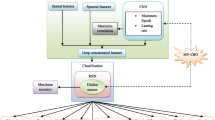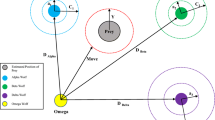Abstract
Classification of remotely sensed hyperspectral images (HSI) is a challenging task due to the presence of a large number of spectral bands and due to the less available data of remotely sensed HSI. The use of 3D-CNN and 2D-CNN layers to extract spectral and spatial features shows good test results. The recently introduced HybridSN model for the classification of remotely sensed hyperspectral images is the best to date compared to the other state-of-the-art models. But the test performance of the HybridSN model decreases significantly with the decrease in training data or number of training epochs. In this paper, we have considered cyclic learning for training of the HybridSN model, which shows a significant increase in the test performance of the HybridSN model with 10%, 20%, and 30% training data and limited number of training epochs. Further, we introduce a new cyclic function (ncf) whose training and test performance is comparable to the existing cyclic learning rate policies. More precisely, the proposed HybridSN(ncf ) model has higher average accuracy compared to HybridSN model by 19.47%, 1.81% and 8.33% for Indian Pines, Salinas Scene and University of Pavia datasets respectively in case of 10% training data and limited number of training epochs.









Similar content being viewed by others
References
Camps-Valls G, Gomez-Chova L, Muñoz-marí J, Vila-Francés J, Calpe-Maravilla J (2006) Composite kernels for hyperspectral image classification. IEEE Geosci Remote Sens Lett 3(1):93–97
Chen Y, Lin Z, Zhao X, Wang G, Gu Y (2014) Deep learning-based classification of hyperspectral data. IEEE J Sel Top Appl Earth Observ Remote Sens 7(6):2094–2107
Fang L, He N, Li S, Plaza AJ, Plaza J (2018) A new spatial–spectral feature extraction method for hyperspectral images using local covariance matrix representation. IEEE Trans Geosci Remote Sens 56(6):3534–3546
Feng F, Wang S, Wang C, Zhang J (2019) Learning deep hierarchical spatial–spectral features for hyperspectral image classification based on residual 3D-2d CNN. Sensors 19(23):5276
Ge Z, Cao G, Li X, Fu P (2020) Hyperspectral image classification method based on 2D-3d CNN and multibranch feature fusion. IEEE J Sel Top Appl Earth Observ Remote Sens 13:5776–5788
He X, Chen Y (2021) Transferring CNN ensemble for hyperspectral image classification. IEEE Geosci Remote Sens Lett 18(5):876–880
Hinton G, Srivastava N, Swersky K (2012) Neural networks for machine learning lecture 6a overview of mini-batch gradient descent. Cited 14(8):2
Jackson JE, A user’s guide to principal components. Wiley New York (1991)
Jing X-Y, Wu F, Zhu X, Dong X, Ma F, Li Z (2016) Multi-spectral low-rank structured dictionary learning for face recognition. Pattern Recogn 59:14–25
Jolliffe I. T. (2002) Principal component analysis. Springer, New York
Kingma DP, Ba J (2014) Adam: A, method for stochastic optimization. arXiv:1412.6980
Kingma DP, Ba J (2015) Adam: A method for stochastic optimization. In: Bengio Y, LeCun Y (eds) 3rd International Conference on Learning Representations, ICLR 2015. Conference Track Proceedings, San Diego
Li J, Huang X, Gamba P, Bioucas-Dias JM, Zhang L, Benediktsson JA, Plaza Antonio (2014) Multiple feature learning for hyperspectral image classification. IEEE Trans Geosci Remote sens 53(3):1592–1606
Li Y, He L (2020) An improved hybrid CNN for hyperspectral image classification. In: Eleventh International Conference on Graphics and Image Processing (ICGIP 2019), vol 11373. International Society for Optics and Photonics, pp 113731R
Makantasis K, Karantzalos K, Doulamis A, Doulamis A (2015) Deep supervised learning for hyperspectral data classification through convolutional neural networks. In: 2015 IEEE International Geoscience and Remote Sensing Symposium (IGARSS). IEEE, pp 4959–4962
Mohan A, Sundaram MV (2021) V3O2: Hybrid deep learning model for hyperspectral image classification using vanilla-3D and octave-2D convolution. J Real-Time Image Proc 18:1681–1695
Mou L, Ghamisi P, Zhu XX (2017) Deep recurrent neural networks for hyperspectral image classification. IEEE Trans Geosci Remote Sens 55 (7):3639–3655
Nyasaka D, Wang J, Tinega H (2020) Learning hyperspectral feature extraction and classification with resN,eXt network. arXiv:2002.02585
Paul A, Bhoumik S, Chaki N (2021) SSNET: an improved deep hybrid network for hyperspectral image classification. Neural Comput Appl 33 (5):1575–1585
Roy SK, Krishna G, Dubey SR, Chaudhuri BB (2019) HybridSN Exploring 3D-2d CNN feature hierarchy for hyperspectral image classification. IEEE Geosci Remote Sens Lett 17(2):277–281
Smith LN (2017) Cyclical learning rates for training neural networks. In: 2017 IEEE Winter Conference on Applications of Computer Vision (WACV). IEEE, pp 464–472
Wu F, Jing X-Y, Dong X, Hu R, Yue D, Wang L, Ji Y-M, Wang R, Chen G (2018) Intraspectrum discrimination and interspectrum correlation analysis deep network for multispectral face recognition. IEEE Trans Cybern 50 (3):1009–1022
Wu F, Jing X-Y, Feng Y, Yi MJ, Wang R (2021) Spectrum-aware discriminative deep feature learning for multi-spectral face recognition. Pattern Recogn:111
Yang J, Qian J (2017) Hyperspectral image classification via multiscale joint collaborative representation with locally adaptive dictionary. IEEE Geosci Remote Sens Lett 15(1):112–116
Yang S, Deng B, Wang J, Li H, Lu M, Che Y, Wei X, Loparo KA (2019) Scalable digital neuromorphic architecture for large-scale biophysically meaningful neural network with multi-compartment neurons. IEEE Trans Neural Netw Learn Syst 31(1):148–162
Yang S, Deng B, Wang J, Liu C, Li H, Lin Q, Fietkiewicz C, Loparo KA (2018) Design of hidden-property-based variable universe fuzzy control for movement disorders and its efficient reconfigurable implementation. IEEE Trans Fuzzy Syst 27(2):304–318
Yang S, Gao T, Wang J, Deng B, Lansdell B, Linares-Barranco B (2021) Efficient spike-driven learning with dendritic event-based processing. Front Neurosci 15:97
Yang S, Wang J, Deng B, Azghadi MR, Linares-Barranco B (2021) Neuromorphic context-dependent learning framework with fault-tolerant spike routing. IEEE Transactions on Neural Networks and Learning Systems
Yang S, Wang J, Hao X, Li H, Wei X, Deng B, Loparo KA (2021) BiCoSS: toward large-scale cognition brain with multigranular neuromorphic architecture. IEEE Transactions on Neural Networks and Learning Systems
Yang S, Wang J, Zhang N, Deng B, Pang Y, Azghadi MR (2021) CerebelluMorphic: large-scale neuromorphic model and architecture for supervised motor learning. IEEE Transactions on Neural Networks and Learning Systems
Yang S, Wei X, Deng B, Liu C, Li H, Wang J (2018) Efficient digital implementation of a conductance-based globus pallidus neuron and the dynamics analysis. Physica A: Stat Mech Appl 494:484–502
Zeiler MD (2012) Adadelta: an adaptive learning rate method. arXiv:1212.5701
Zhong Z, Li J, Luo Z, Chapman M (2017) Spectral–spatial residual network for hyperspectral image classification: a 3D deep learning framework. IEEE Trans Geosci Remote Sens 56(2):847–858
Zhu L, Chen Y, Ghamisi P, Benediktsson JA (2018) Generative adversarial networks for hyperspectral image classification. IEEE Trans Geosci Remote Sens 56(9):5046–5063
Author information
Authors and Affiliations
Corresponding author
Ethics declarations
Conflict of Interests
The authors declare that they have no confict of interest.
Additional information
Publisher’s note
Springer Nature remains neutral with regard to jurisdictional claims in published maps and institutional affiliations.
Rights and permissions
About this article
Cite this article
Vaish, P.P., Rani, K. & Kumar, S. Cyclic learning rate based HybridSN model for hyperspectral image classification. Multimed Tools Appl 81, 32723–32738 (2022). https://doi.org/10.1007/s11042-022-12679-5
Received:
Revised:
Accepted:
Published:
Issue Date:
DOI: https://doi.org/10.1007/s11042-022-12679-5




